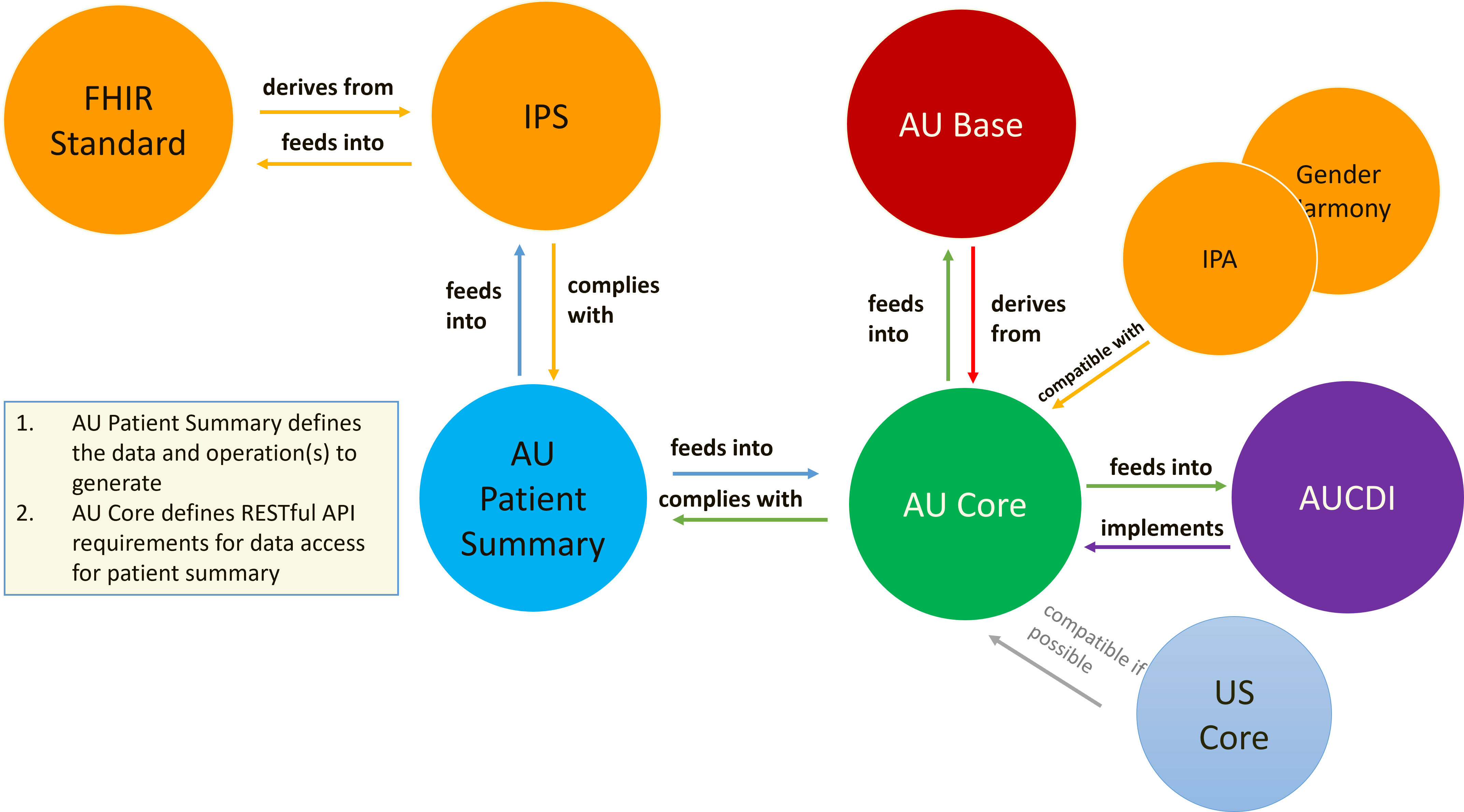AU Patient Summary Implementation Guide
0.6.0-cibuild - CI Build
AU Patient Summary Implementation Guide
0.6.0-cibuild - CI Build
AU Patient Summary Implementation Guide, published by HL7 Australia. This guide is not an authorized publication; it is the continuous build for version 0.6.0-cibuild built by the FHIR (HL7® FHIR® Standard) CI Build. This version is based on the current content of https://github.com/hl7au/au-fhir-ps/ and changes regularly. See the Directory of published versions
| Page standards status: Informative |
This guide is built on top of the FHIR standard and, where available, AU Core, IPS, and AU Base. AU Patient Summary (AU PS) is compliant with the conformance requirements in IPS and the profile only conformance requirements in AU Core.
The context of AU PS within the set of HL7 AU standards is shown in the figure below:
This layering of IGs balances relative adoption and implementation maturity of FHIR and requirements of the use cases involved.

Figure 1: Context of AU PS within the set of HL7 AU standards
The primary intent of the AUCDI is to design and govern a collection of coherent, reusable building blocks known as data groups. These data groups specify “what” the clinical requirements of the clinical information that should be included for data entry, data use, and sharing of information supporting healthcare delivery. However, it does not specify 'how' the data is exchanged; this is the role fulfilled by the FHIR standard. AUCDI is not required to be implemented as a whole single product. Parts can be implemented as required for specific use cases.
AUCDI R2 builds upon R1, expanding on the initial 'core', introducing additional data groups and data elements to support different use cases including 'Patient summary'. These AUCDI 'Patient summary' data groups comprising one or more data elements, references clinical terminology concepts, forming the foundation of a common language to allow systems to exchange semantically accurate data more efficiently for patient summaries.
AU PS is a technical specification that addresses constraints and obligations on data representation for exchange. AU PS enables system data to be mapped to an agreed FHIR format, produced, and consumed by systems in Australia.
AU PS is based on, aligns to, and leverages international standards and other national standards. Corresponding profiles included in relevant FHIR implementation guides were reviewed and considered during the development process to ensure alignment and to facilitate adoption of this standard. These implementation guides include:
See AUCDI for the relationship between the 'Patient summary' AUCDI data groups, elements, and AU PS profiles.
The relationship of AU PS to AUCDI and other implementation guides is shown in the figure below.

Figure 2: Relationship to AUCDI and Other IGs
| Implementation Guide | Relationship |
|---|---|
| AU Base | This IG defines Australian realm concepts including terminology, identifiers, and extensions. AU PS uses AU Base, where available, as the basis for profiles that define the FHIR resources to be supported, and the elements, extensions, vocabularies, and value sets that SHALL be present are identified, and how they are used is defined. Where available and applicable, AU Base concepts are profiled in AU Core and inherited by AU PS. |
| HL7 Cross Paradigm Implementation Guide: Gender Harmony - Sex and Gender Representation | This IG provides definitive guidance on how to exchange clinical sex and gender affirming information using HL7 models. Sex and gender concepts from this IG have been reviewed for the potential for adoption in Australia. Where adopted, these concepts are included by reference in AU Base, profiled in AU Core, and inherited by AU PS. |
| AU Core | This IG defines a set of conformance requirements that enforce a set of 'minimum requirements' on the local concepts from AU Base, specifying the elements, extensions, vocabularies, and value sets that SHALL be present and how they SHALL be used. AU Core also defines a data access API, specifying the conformance requirements for RESTful interactions. AU PS is compliant with the profile only requirements of AU Core, e.g. AU Core conformant data can be used to generate an AU PS document and AU PS conformant data can be accessed by an AU Core conformant requester. |
| International Patient Access 1.1.0 | This IG describes how an application acting on behalf of a patient can access information about the patient from a clinical records system using a FHIR based API. The REST API and profiles in this IG were reviewed and considered during development of AU Core and AU PS. AU PS is designed to be compatible with the RESTful data access in IPA, e.g. AU PS conformant data and AU PS documents can be accessed by an IPA conformant client. |
| International Patient Summary 2.0.0 | This IG describes how to represent in HL7 FHIR the International Patient Summary (IPS). An International Patient Summary (IPS) document is an electronic health record extract containing essential healthcare information about a subject of care. This IG defines a set of conformance requirements that enforce a set of 'minimum requirements' on the data and obligations on systems generating and consuming IPS documents. AU PS is compliant with the requirements of IPS, e.g. AU PS data is conformant to IPS and systems that generate and consume AU PS documents are conformant to the requirements in IPS. |